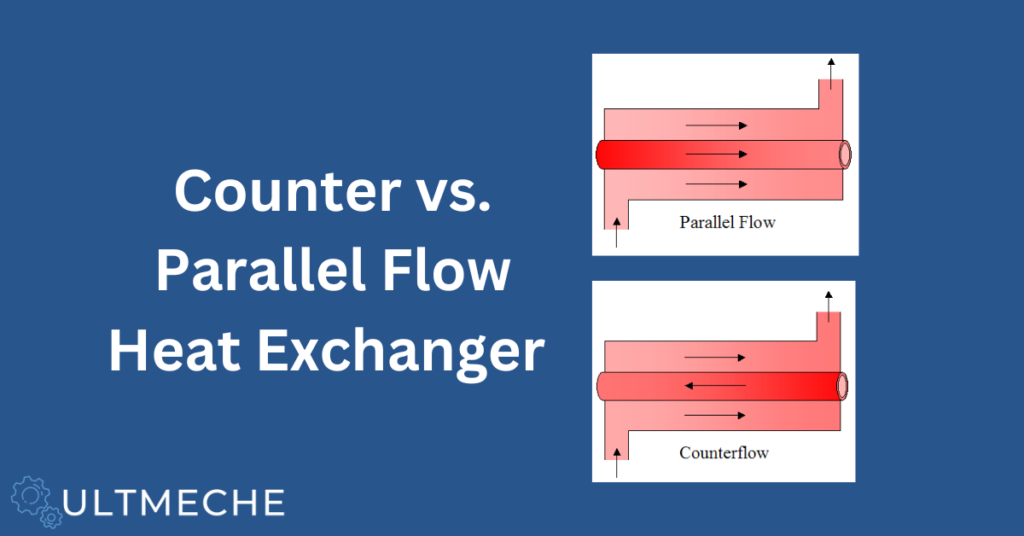The concept of Counter Flow vs Parallel Flow in a Heat Exchanger comes up in your heat transfer class and it is important to understand.
If you don’t understand this basic concept, you won’t be able to get the job.
Think companies like Tesla, SpaceX, Blue Origin, Boeing, Raytheon, Northrop Grumman, etc.
Understanding this mechanism is necessary for both for a job interview and for general knowledge as a Mechanical Engineer.
You will not provide value if you don’t understand the concepts of basic heat transfer interview questions, especially for thermal roles in mechanical engineering.
Engineering classes go very in depth, but in reality you only need to know the basics.
This post will aim to bridge the gap between what you learned in class and what you need to know to land your dream engineering job.

April 4, 2025 by Kazu Fujimoto
A heat exchanger is a device that transfers heat between two fluids without mixing them. The terms “parallel flow” and “counter flow” describe the direction in which these fluids move relative to each other, affecting the efficiency and performance of the heat transfer process. Refer to the image above for the direction of the fluid flow.
Parallel Flow Heat Exchanger
In a parallel flow heat exchanger, both the hot and cold fluids flow in the same direction. They enter the exchanger at one end and exit at the opposite end, moving alongside each other, as indicated by the arrows in the above image.
Heat Transfer Characteristics: The temperature difference between the two fluids is highest at the inlet and decreases along the length of the exchanger as the hot fluid cools and the cold fluid warms. However, the temperature of the cold fluid can never exceed the outlet temperature of the hot fluid, limiting the maximum heat transfer.
Advantages: Simpler design and construction; useful when only moderate temperature changes are needed.
Disadvantages: Less efficient because the temperature difference diminishes along the flow path, reducing the driving force for heat transfer.
Example: Imagine hot water and cold water flowing through two adjacent pipes in the same direction. The cold water heats up, but it can’t get hotter than the exiting warm water.
Counter Flow Heat Exchanger
In a counter flow heat exchanger, the hot and cold fluids flow in opposite directions. The hot fluid enters at one end, while the cold fluid enters at the opposite end, and they pass each other as they move through the exchanger. Notice the arrow direction in the above image for the parallel flow vs. counter flow (they are opposing).
Heat Transfer Characteristics: The temperature difference between the fluids remains more consistent along the length of the exchanger. This allows for greater heat transfer because the cold fluid can potentially reach a temperature close to the inlet temperature of the hot fluid (and vice versa), maximizing efficiency.
Advantages: More efficient due to a sustained temperature gradient; ideal for applications requiring significant temperature changes.
Disadvantages: Slightly more complex design and potentially higher pressure drops.
Example: Picture hot water entering one end of a pipe and cold water entering the other end, flowing past each other. The cold water can theoretically approach the initial temperature of the hot water, making it more effective.
Key Differences
- Flow Direction:
- Parallel: Fluids flow in the same direction.
- Counter: Fluids flow in opposite directions.
- Efficiency:
- Parallel: Less efficient due to a decreasing temperature difference.
- Counter: More efficient due to a more uniform temperature difference.
- Temperature Limits:
- Parallel: The cold fluid’s outlet temperature cannot exceed the hot fluid’s outlet temperature.
- Counter: The cold fluid can approach the hot fluid’s inlet temperature, allowing for greater heat recovery.
- Applications:
- Parallel: Used in simpler systems or where full heat recovery isn’t critical (e.g., some car radiators).
- Counter: Preferred in high-efficiency systems like industrial heat recovery units or cryogenic processes.
Why Counter Flow is More Efficient Than Parallel Flow in a Heat Exchanger
To understand why a counter flow heat exchanger is more efficient than a parallel flow one, we can dive into the math behind heat transfer, focusing on the temperature profiles and the resulting heat transfer rate.
The efficiency comes down to how the temperature difference between the fluids is maintained, which drives the heat transfer.
Let’s break it down step-by-step.
Heat Transfer Rate
Heat Transfer Rate (Q): The amount of heat transferred in a heat exchanger is given by:

Where:
- U – Overall heat transfer coefficient (W/m²·K)
- A – Heat transfer surface area (m²)
- ΔTm – Logarithmic mean temperature difference (LMTD), which accounts for the temperature gradient across the exchanger.
Logarithmic Mean Temperature Difference

Where:
ΔT1 – Temperature difference at point 1 in the heat exchanger
ΔT2 – Temperature difference at point 2 in the heat exchanger
The LMTD is critical because it represents the effective average temperature difference driving the heat transfer. A larger LMTD means more heat can be transferred for the same U (overall heat transfer coefficient) and A (heat transfer surface area).
Assume the following:
- Two fluids: Hot fluid (H) and cold fluid (C).
- Hot fluid – TH,in for inlet and TH,out for outlet
- Cold fluid – TC,in for inlet and TC,out for outlet
- Same mass flow rates and specific heats
- Same overall heat transfer coefficient (U) and heat transfer surface area (A)
Let’s use values:
TH,in = 100∘C
TC,in = 20∘C
TH,out = 60∘C
And find what TC,out is.
Using the standard equation for energy balance, we get:

TC,out = 60∘C
Parallel Flow Example Calculation
Let’s use values:
TH,in = 100∘C
TC,in = 20∘C
TH,out = 60∘C
TC,out = 59∘C
In parallel flow, both fluids enter at the same end: (In – in and out – out)
ΔT1 = TH,in – TC,in = 100 – 20 = 80∘C
ΔT2 = TH,out – TC,out = 100 – 59 = 1∘C
Calculate the LMTD:

Counter Flow Example Calculation
We’ll use the same values above, but ΔT1 and ΔT2 will be different due to the different flow configuration.
ΔT1 = TH,in – TC,out = 100 – 59 = 41∘C
ΔT2 = TH,out – TC,in = 60 – 20 = 40∘C
Doing this step by step:

Comparing the values for the counter flow and parallel flow example, we get:
Parallel Flow LMTD = 18∘C
Counter Flow LMTD = 40∘C
Because Q = U x A x ΔTm and the overall heat transfer U and surface area A are the same,
Qcounter / Qparallel = 40/18 = 2.22
Meaning that counter flow transfers twice as much heat in these conditions.
This shows that counter flow heat exchanger is a much more efficient arrangement when compared to parallel flow heat exchanger.
About the author

Kazuyoshi Fujimoto, PE
Founder | Engineering Career Coach | Principal Mechanical Engineer
Kazu oversees all of ultmeche’s engineering services. He provides consulting such as resume reviews, rewrites, mock interviews, and all services career related. Additionally, Kazu performs consulting work regarding Oil & Gas, Automotive, and Aerospace & Defense. Kazu is licensed as a professional engineer in the state of California and has 9+ years of experience in Oil & Gas, Automotive, and Aerospace & Defense.
